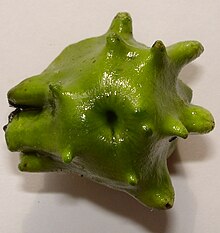Andricus quercuscalicis
| Andricus quercuscalicis | |
|---|---|
 |
|
| Mature gall on oak | |
| Scientific classification | |
| Kingdom: | Animalia |
| Phylum: | Arthropoda |
| Class: | Insecta |
| Order: | Hymenoptera |
| Family: | Cynipidae |
| Genus: | Andricus |
| Species: | A. quercuscalicis |
| Binomial name | |
|
Andricus quercuscalicis (Burgsdorf, 1783) |
|
Andricus quercuscalicis is a gall wasp species inducing knopper galls.
Knopper galls develop as a chemically induced distortion of growing acorns on pedunculate oak (Quercus robur L.) trees, caused by gall wasps, which lay eggs in buds with their ovipositor. The gall thus produced can greatly reduce the fecundity of the oak host, making this gall potentially more of a threat to the reproductive ability of the tree than those that develop on leaves, buds, stems, etc. The Turkey Oak (Quercus cerris L.), introduced into Britain in 1735, is required for the completion of the life cycle of the gall. The knopper is a recent introduction to the British Isles, first arriving in the 1960s and now found throughout England, Wales and as far north as Scotland; first occurring for example in 2007 at Eglinton Country Park in North Ayrshire.
The large 2 cm gall growth appears as a mass of green to yellowish-green, ridged, and at first sticky plant tissue on the bud of the oak, that breaks out as the gall between the cup and the acorn. If only a few grubs are developing within, then it may appear only as a group of bland folds. Where several grubs are competing for space the shape may become much more contorted, with several tightly bunched galls.
The word knopper derives from the German word 'Knoppe', meaning a kind of felt cap or helmet worn during the 17th century; also a small rounded protuberance, often decorative, such as a stud, a tassel or a knob.
Although normally distinctive the knopper gall can, under some growth conditions, be mistaken for the acorn cup gall, caused by the gall wasp Andricus grossulariae.
A number of insect inquilines live harmlessly within the knopper gall and some of these, as well as A. quercuscalicis itself, are parasitised by insects referred to as parasitoids.
Andricus quercuscalicis (Burgsdorf, 1783) (Hymenoptera: Cynipidae) is a small gall wasp with an obligate two-phase life-cycle that requires both pedunculate oak (Q. robur L.) (or occasionally sessile oak Q.petraea L.) and Turkey oak (Quercus cerris L.). Therefore, as with most oak gall wasps, this species has alternate sexual and parthenogenetic (all female) generations. The sexual generation develops in spring in small conical galls that form on the male catkins of the Turkey oak.
...
Wikipedia
